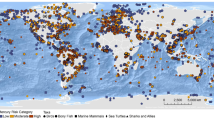Summary
This paper describes a simplified model which links the sedimentary concentration of selected biomarkers to their export primary production, their stability during transit to the anoxic sediment layer and the sediment bulk sedimentation rate. Manipulation of the biomarker data permits the individual effects of these processes to be separated. Examples demonstrate the use of this strategy in the evaluation of environmentally significant parameters.
Similar content being viewed by others
References
Eglinton G (1985) The alchemy of life: probing the molecular record. In: Nash S (ed) Science and Uncertainty. Sci Rev, pp 192–219
Eckardt C-B, Eglinton G, Dyas L, Yendle P (1988) Org Geochem 13:573–582
Corey A-J, Xue-Min Cheng (1989) The logic of chemical synthesis. Wiley, Chichester New York, p 427
Mello M-R, Gaglianone P-C, Brassell S-C, Maxwell J-R (1988) Mar Pet Geol 5:205–223
Brassell S-C, Brereton R-G, Eglinton G, Grimalt JO, Liebezeit G, Marlowe IT, Pflaumman U, Sarnthein M (1986) Org Geochem 10:649–660
Marlowe I-T (1984) Lipids as palaeoclimatic indicators. Ph.D. thesis, University of Bristol
Poynter J-G, Farrimond P, Brassell S-C, Eglinton G (1989) Molecular stratigraphic study of sediments from holes 658A and 660A, Leg 108. In: Ruddiman W, Sarnthein M (eds) Proc of the ODP, College Station, Texas, Sci Res, vol 108, pp 387–394
Prahl F-G, de Lange G-J, Lyle M, Sparrow M-A (1989) Nature 341:434–436
Recka J, Maxwell J-R (1988) Tetrahedron Lett 21:2599–2600
Johansson E, Wold S, Sjodin K (1984) Anal Chem 56:1685–1688
Poynter J-G (1989) The recognition of palaeoclimatic signals in organic geochemical data. Ph.D. thesis, University of Bristol
Poynter J-G, Eglinton G (1991) A possible link between the historical species succession of prymnesiophyte algae and time series describing long chain alkenone distributions: an application of chemotaxonomy (in preparation)
Savitzky A, Golay J-E (1964) Anal Chem 36:1627–1639
Imbric J, Hays J-D, Martinson D-G, McIntyre A, Mix A-C, Morley J-J, Pisias N-G, Prell W-L, Shackleton N-J (1984) In: Berger A-L (ed) The orbital theory of pleistocene climate: support from a revised chronology of marine sediments 18O record. In: Milankovitch and Climate. Reidel, Dordrecht, The Netherlands, pp 269–305
Prell W-L, Imbrie J, Martinson D-J, Nicklas J-M, Pisias N-G, Harold F-S (1986) Palaeoceanography 1:137–162
Stransky K, Streibi M, Herout V (1967) In: Natural Waxes. VI. Collect Czech Chem Commun 32:3213–3220
White F (1983) The vegetation of Africa: a descriptive memoir to accompany the UNESCO AETFAT UNSO vegetation map of Africa. UNESCO, Paris
Poynter J-G, Farrimond P, Robinson N, Eglinton G (1989) Aeolian derived higher plant lipids in the marine sedimentary record: links with palaeoclimate. In: Leinen M, Sarnthein M (eds) Palaeoclimatology and palaeometeorology: modern and past patterns of global atmospheric transport. Kluwer, Academic Press, Dordrecht, The Netherlands, pp 435–462
Sarnthein M, Winn H, Zahn R (1987) Palaeoceanography of oceanic upwelling and the effect on Atmospheric CO2 and climatic change during deglaciation time. In: Berger W-H, Labeyrie L-D (eds) Abrupt climatic change. Reidel, Dordrecht, The Netherlands, pp 311–327
ten Haven H-L, Baas M, de Leeuw J-W, Schenck P-A, Brinkus H (1987) Mar Geol 64:149–167
Rossignol-Strick M, Nesteroff W, Olive P, Vergnaud-Grazzini C (1982) Nature 295:105–110
Bradshaw S-B, O'Hara S-C-M, Corner E-D-S, Eglinton G (1989) J Mar Biol Assoc UK 69:891–911
Brassell S-C, Eglinton G, Maxwell J-R (1983) Biochem Soc Trans 11:575–586
Teshima S, Kanazawa A, Okamoto H (1976) Bull Jap Soc Sci Fish 42:1273–1280
Ruddiman W, Sarnthein M (1989) Proc ODP Sci Results 108. College Station, Texas (Ocean Drilling Program)
Goad L-J (1978) The sterols of marine invertebrates: composition, biosynthesis and metabolites. In: Scheuer P-A (ed). Marine natural products: chemical and biological perspectives. II. Academic Press, New York, pp 75–172
Harvey H-R, O'Hara S-C-M, Eglinton G, Corner E-D-S (1989) Org Geochem 14:232–242
Author information
Authors and Affiliations
Rights and permissions
About this article
Cite this article
Poynter, J., Eglinton, G. The biomarker concept — strengths and weaknesses. Fresenius J Anal Chem 339, 725–731 (1991). https://doi.org/10.1007/BF00321733
Received:
Issue Date:
DOI: https://doi.org/10.1007/BF00321733




